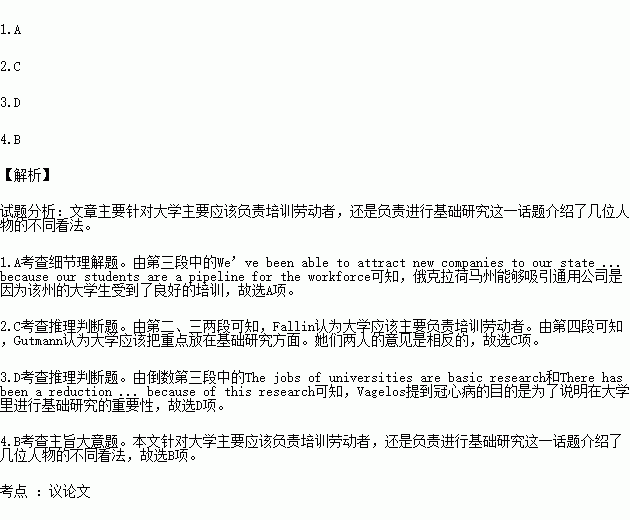题目内容
Should universities focus on training workers for the next decade or curing diseases for the next century? A group of governors, educators, and CEOs weighed in on the best way universities can prepare for the future. They debated how the U.S. can take the responsibility for research while still preparing students for real jobs.
Oklahoma Governor Mary Fallin said that the first thing she thinks about as governor is educating Oklahoma students and strengthening the workforce. So she’s carrying out a program called “America Works: Education and Training for Tomorrow’s Jobs” that aims to “reorganize our education system with the current needs of our employers”.
The state governor added that this new educational approach doesn’t just benefit students and companies, but also improves the state economy. “We’ve been able to attract new companies to our state because of what we’re doing with our universities, because our students are a pipeline for the workforce,” she said. “General Electric Company (one of the world’s biggest companies) is coming to Oklahoma.”
Other group members were more focused on the long-term goals of a research university. Amy Gutmann pointed out that “basic research is the foundation for everything else that happens at a university. And if we don’t do it, nobody else will.”
“And if nobody does that research, we’ll pay the price in health care bills,” argued Vagelos, who is a former CEO of Merck & Co., Inc, one of the largest pharmaceutical (制药的) companies in the world. “The jobs of universities are basic research, which is what is needed for attacks on disease,” he said. “There has been a reduction in coronary heart disease (冠心病) by 60% in the last forty years because of this research, and that reduces health care costs.”
James Hunt, former North Carolina governor, argued for a happy medium. Effective communication, he said, would help the public see that the research conducted at universities actually serves a practical purpose.
Eli Broad, founder of the Broad Foundations, agreed. “We have to show the public what research has achieved,” he said. “We have to show how it actually goes from basic research to something they can understand.”
1.Why does Oklahoma appeal to General Electric Company?
A. University graduates in the state are well trained.
B. There’s much support from the local government.
C. Many students in the state hope to be workers.
D. The state economy has been growing rapidly.
2.What is Gutmann’s attitude toward Fallin’s program?
A. Curious. B. Tolerant.
C. Disapproving. D. Sympathetic.
3.Vagelos mentioned coronary heart disease in order to show _____.
A. the achievements of Merck & Co., Inc
B. the difficulty of developing new drugs
C. the heavy burden of health care costs
D. the importance of basic research
4.Which of the following can be the best title of this text?
A. Universities or colleges?
B. Workers or researchers?
C. Basic or further research?
D. Education or development?

